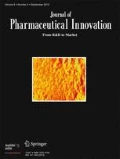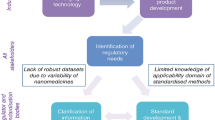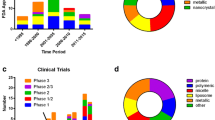Abstract
Purpose
A common approach to “Quality-by-Design” is to employ quality software(s) to characterize the impacts of input parameters on output-critical quality attributes. In this study, paclitaxel (PTX), a common chemotherapeutic agent, was loaded into poly-lactic-co-glycolic acid (PLGA) nanoparticles (NPs), and the coating process of chitosan (CS) onto PLGA NPs was focused for optimization.
Method
Experiments were designed using Modde 8.0 to set up a D-optimal design for inputs (CS/PLGA ratios, temperature, and pH), and particle size (Z), zeta potential (Zeta), polydispersity index (PDI), encapsulation efficiency (EE), and loading capacity (LC) were the selected outputs. Data analysis was performed using Modde 8.0 concurrently with artificial neural networks such as INform 3.1 and FormRules 2.0. Furthermore, enhancement of cytotoxicity, cellular uptake, and apoptosis by CS coating were also determined.
Results
The results confirmed the influence of inputs on output ones (R2 > 90%). The optimized formulation showed Z of 161.53 ± 0.97 nm, PDI of 0.270 ± 0.007, Zeta of 41.87 ± 1.42 mV, and EE of 98.59 ± 0.22%; the results were close to the predicted calculations. The optimal formulation, CS-PLGA NPs, showed higher cytotoxicity than PLGA NPs in Hela and SK-LU-1 cell-lines (cell viability assay). Furthermore, apoptosis and intracellular uptake studies confirmed enhancement of the CS layer.
Conclusion
The data reveal the validity of optimization models and their potential in anti-cancer therapy, especially for lung and cervical cancer treatment.







Similar content being viewed by others
References
Pandey P, Bharadwaj R, Chen X. Modeling of drug product manufacturing processes in the pharmaceutical industry. Predictive modeling of pharmaceutical unit operations: Elsevier; 2017. p. 1–13.
Guideline IHT. Pharmaceutical development. Q8 (2R). As revised in august. 2009.
Lawrence XY, Amidon G, Khan MA, Hoag SW, Polli J, Raju G, et al. Understanding pharmaceutical quality by design. AAPS J. 2014;16(4):771–83.
Li Z, Cho BR, Melloy BJ. Quality by design studies on multi-response pharmaceutical formulation modeling and optimization. J Pharm Innov. 2013;8(1):28–44.
Nguyen C, Christensen JM, Nguyen T. Application of D-optimal study design with contour surface response for designing sustained release gliclazide matrix tablets. Pharmacol Pharma. 2014;2014
Ho HN, Tran TH, Tran TB, Yong CS, Nguyen CN. Optimization and characterization of artesunate-loaded chitosan-decorated poly (D, L-lactide-co-glycolide) acid nanoparticles. J Nanomater. 2015;2015:1–12.
Ren S, Mu H, Alchaer F, Chtatou A, Müllertz A. Optimization of self nanoemulsifying drug delivery system for poorly water-soluble drug using response surface methodology. Drug Dev Ind Pharm. 2013;39(5):799–806.
Liu Z, Bruwer M-J, MacGregor JF, Rathore SS, Reed DE, Champagne MJ. Modeling and optimization of a tablet manufacturing line. J Pharm Innov. 2011;6(3):170–80.
Esnaashari SS, Amani A. Optimization of noscapine-loaded mPEG-PLGA nanoparticles and release study: a response surface methodology approach. J Pharm Innov. 2018:1–10.
Turkoglu M, Aydin I, Murray M, Sakr A. Modeling of a roller-compaction process using neural networks and genetic algorithms. Eur J Pharm Biopharm. 1999;48(3):239–45.
Pharmacists ASoH. AHFS drug information. Published by authority of the Board of Directors of the American Society of Hospital Pharmacists; 2012.
Bishop JF, Dewar J, Toner GC, Smith J, Tattersall MH, Olver IN, et al. Initial paclitaxel improves outcome compared with CMFP combination chemotherapy as front-line therapy in untreated metastatic breast cancer. J Clin Oncol. 1999;17(8):2355–64.
Yang R, Yang SG, Shim WS, Cui F, Cheng G, Kim IW, et al. Lung-specific delivery of paclitaxel by chitosan-modified PLGA nanoparticles via transient formation of microaggregates. J Pharm Sci. 2009;98(3):970–84.
Gradishar WJ, Tjulandin S, Davidson N, Shaw H, Desai N, Bhar P, et al. Phase III trial of nanoparticle albumin-bound paclitaxel compared with polyethylated castor oil–based paclitaxel in women with breast cancer. J Clin Oncol. 2005;23(31):7794–803.
Weiss RB, Donehower RC, Wiernik PH, Ohnuma T, Gralla RJ, Trump DL, et al. Hypersensitivity reactions from taxol. J Clin Oncol. 1990;8(7):1263–8. https://doi.org/10.1200/jco.1990.8.7.1263.
Danhier F, Lecouturier N, Vroman B, Jérôme C, Marchand-Brynaert J, Feron O, et al. Paclitaxel-loaded PEGylated PLGA-based nanoparticles: in vitro and in vivo evaluation. J Control Release. 2009;133(1):11–7.
Fonseca C, Simoes S, Gaspar R. Paclitaxel-loaded PLGA nanoparticles: preparation, physicochemical characterization and in vitro anti-tumoral activity. J Control Release. 2002;83(2):273–86.
Tran BN, Nguyen HT, Kim JO, Yong CS, Nguyen CN. Developing combination of artesunate with paclitaxel loaded into poly-D, L-lactic-co-glycolic acid nanoparticle for systemic delivery to exhibit synergic chemotherapeutic response. Drug Dev Ind Pharm. 2017;43(12):1952–62.
Yang R, Shim W-S, Cui F-D, Cheng G, Han X, Jin Q-R, et al. Enhanced electrostatic interaction between chitosan-modified PLGA nanoparticle and tumor. Int J Pharm. 2009;371(1):142–7.
Parveen S, Sahoo SK. Long circulating chitosan/PEG blended PLGA nanoparticle for tumor drug delivery. Eur J Pharmacol. 2011;670(2):372–83.
Tran TH, Nguyen TD, Poudel BK, Nguyen HT, Kim JO, Yong CS, et al. Development and evaluation of artesunate-loaded chitosan-coated lipid nanocapsule as a potential drug delivery system against breast cancer. AAPS PharmSciTech. 2015;16(6):1307–16.
Rowe RC, Sheskey PJ, Quinn ME, Association AP. Handbook of Pharmaceutical Excipients: Pharmaceutical Press; 2009.
Martin-Banderas L, Duran-Lobato M, Munoz-Rubio I, Alvarez-Fuentes J, Fernandez-Arevalo M, A Holgado M. Functional PLGA NPs for oral drug delivery: recent strategies and developments. Mini-Rev Med Chem. 2013;13(1):58–69.
Abdelrahman AA, Salem HF, Khallaf RA, Ali AMA. Modeling, optimization, and in vitro corneal permeation of chitosan-lomefloxacin HCl nanosuspension intended for ophthalmic delivery. J Pharm Innov. 2015;10(3):254–68.
Nguyen HT, Tran TH, Kim JO, Yong CS, Nguyen CN. Enhancing the in vitro anti-cancer efficacy of artesunate by loading into poly-D, L-lactide-co-glycolide (PLGA) nanoparticles. Arch Pharm Res. 2015;38(5):716–24.
Rowe R, COLBOURN E. Formulating Knowledge. Innov Pharm Technol. 2006;20:70–4.
Colbourn E, Roskilly S, Rowe R, York P. Modelling formulations using gene expression programming–a comparative analysis with artificial neural networks. Eur J Pharm Sci. 2011;44(3):366–74.
Abbasi S, Afrasiabi A, Zarchi AAK, Faramarzi MA, Tavoosidana G, Amani A. Preparation and optimization of N-acetylcysteine nanosuspension through nanoprecipitation: an artificial neural networks study. J Pharm Innov. 2014;9(2):115–20.
Malvern_Instruments. Zetasizer nano series user manual. Worcestershire: Malvern Instruments Ltd. 2004.
Malvern_Instruments. Dynamic light scattering: an introduction in 30 minutes. Technical Note Malvern, MRK656–01. 2012:1–8.
Tran TH, Choi JY, Ramasamy T, Truong DH, Nguyen CN, Choi H-G, et al. Hyaluronic acid-coated solid lipid nanoparticles for targeted delivery of vorinostat to CD44 overexpressing cancer cells. Carbohydr Polym. 2014;114:407–15.
Tran TH, Nguyen HT, Pham TT, Choi JY, Choi H-G, Yong CS, et al. Development of a graphene oxide nanocarrier for dual-drug chemo-phototherapy to overcome drug resistance in cancer. ACS Appl Mater Interfaces. 2015;7(51):28647–55.
Hughes JP, Rees S, Kalindjian SB, Philpott KL. Principles of early drug discovery. Br J Pharmacol. 2011;162(6):1239–49.
Scudiero DA, Shoemaker RH, Paull KD, Monks A, Tierney S, Nofziger TH, et al. Evaluation of a soluble tetrazolium/formazan assay for cell growth and drug sensitivity in culture using human and other tumor cell lines. Cancer Res. 1988;48(17):4827–33.
Wu X, Liu H, Liu J, Haley KN, Treadway JA, Larson JP, et al. Immunofluorescent labeling of cancer marker Her2 and other cellular targets with semiconductor quantum dots. Nat Biotechnol. 2003;21(1):41–6.
Park E-J, Yi J, Chung K-H, Ryu D-Y, Choi J, Park K. Oxidative stress and apoptosis induced by titanium dioxide nanoparticles in cultured BEAS-2B cells. Toxicol Lett. 2008;180(3):222–9.
Oyaizu H, Adachi Y, Taketani S, Tokunaga R, Fukuhara S, Ikehara S. A crucial role of caspase 3 and caspase 8 in paclitaxel-induced apoptosis. Mol Cell Biol Res Commun. 1999;2(1):36–41.
Kim JA, Åberg C, Salvati A, Dawson KA. Role of cell cycle on the cellular uptake and dilution of nanoparticles in a cell population. Nat Nanotechnol. 2012;7(1):62–8.
Liebmann J, Cook JA, Lipschultz C, Teague D, Fisher J, Mitchell JB. The influence of Cremophor EL on the cell cycle effects of paclitaxel (Taxol®) in human tumor cell lines. Cancer Chemother Pharmacol. 1994;33(4):331–9.
Arıca Yegin B, Benoît J-P, Lamprecht A. Paclitaxel-loaded lipid nanoparticles prepared by solvent injection or ultrasound emulsification. Drug Dev Ind Pharm. 2006;32(9):1089–94.
Shao Q, Rowe RC, York P. Comparison of neurofuzzy logic and neural networks in modelling experimental data of an immediate release tablet formulation. Eur J Pharm Sci. 2006;28(5):394–404.
Aksu B, Paradkar A, de Matas M, Özer Ö, Güneri T, York P. Quality by design approach: application of artificial intelligence techniques of tablets manufactured by direct compression. AAPS PharmSciTech. 2012;13(4):1138–46.
Ofir R, Seidman R, Rabinski T, Krup M, Yavelsky V, Weinstein Y, et al. Taxol-induced apoptosis in human SKOV3 ovarian and MCF7 breast carcinoma cells is caspase-3 and caspase-9 independent. Cell Death Differ. 2002;9(6):636–42.
Chu C, Xu J, Cheng D, Li X, Tong S, Yan J, et al. Anti-proliferative and apoptosis-inducing effects of camptothecin-20 (s)-O-(2-pyrazolyl-1) acetic ester in human breast tumor MCF-7 cells. Molecules. 2014;19(4):4941–55.
Darzynkiewicz Z, Bruno S, Del Bino G, Gorczyca W, Hotz M, Lassota P, et al. Features of apoptotic cells measured by flow cytometry. Cytometry Part A. 1992;13(8):795–808.
Rowinsky EK, Cazenave LA, Donehower RC. Taxol: a novel investigational antimicrotubule agent. JNCI: J Ntnl Cancer Institute. 1990;82(15):1247–59.
Colbourn EA, Rowe RC. Advanced neural computing software systems: data mining in processing and formulation. 2006.
Shao Q, Rowe RC, York P. Investigation of an artificial intelligence technology—model trees: novel applications for an immediate release tablet formulation database. Eur J Pharm Sci. 2007;31(2):137–44.
Jain RA. The manufacturing techniques of various drug loaded biodegradable poly (lactide-co-glycolide)(PLGA) devices. Biomaterials. 2000;21(23):2475–90.
Singla A, Chawla M. Chitosan: some pharmaceutical and biological aspects-an update. J Pharm Pharmacol. 2001;53(8):1047–67.
Xiong S, Zhao X, Heng BC, Ng KW, Loo JSC. Cellular uptake of poly-(D, L-lactide-co-glycolide)(PLGA) nanoparticles synthesized through solvent emulsion evaporation and nanoprecipitation method. Biotechnol J. 2011;6(5):501–8.
Mehrishi J. Effect of lysine polypeptides on the surface charge of normal and cancer cells. Eur J Cancer (1965). 1969;5(5):427–35.
Author information
Authors and Affiliations
Corresponding author
Ethics declarations
Conflicts of Interest
The authors declare that they have no conflict of interest.
Rights and permissions
About this article
Cite this article
Nguyen, C.N., Tran, B.N., Do, T.T. et al. D-Optimal Optimization and Data-Analysis Comparison Between a DoE Software and Artificial Neural Networks of a Chitosan Coating Process onto PLGA Nanoparticles for Lung and Cervical Cancer Treatment. J Pharm Innov 14, 206–220 (2019). https://doi.org/10.1007/s12247-018-9345-x
Published:
Issue Date:
DOI: https://doi.org/10.1007/s12247-018-9345-x




